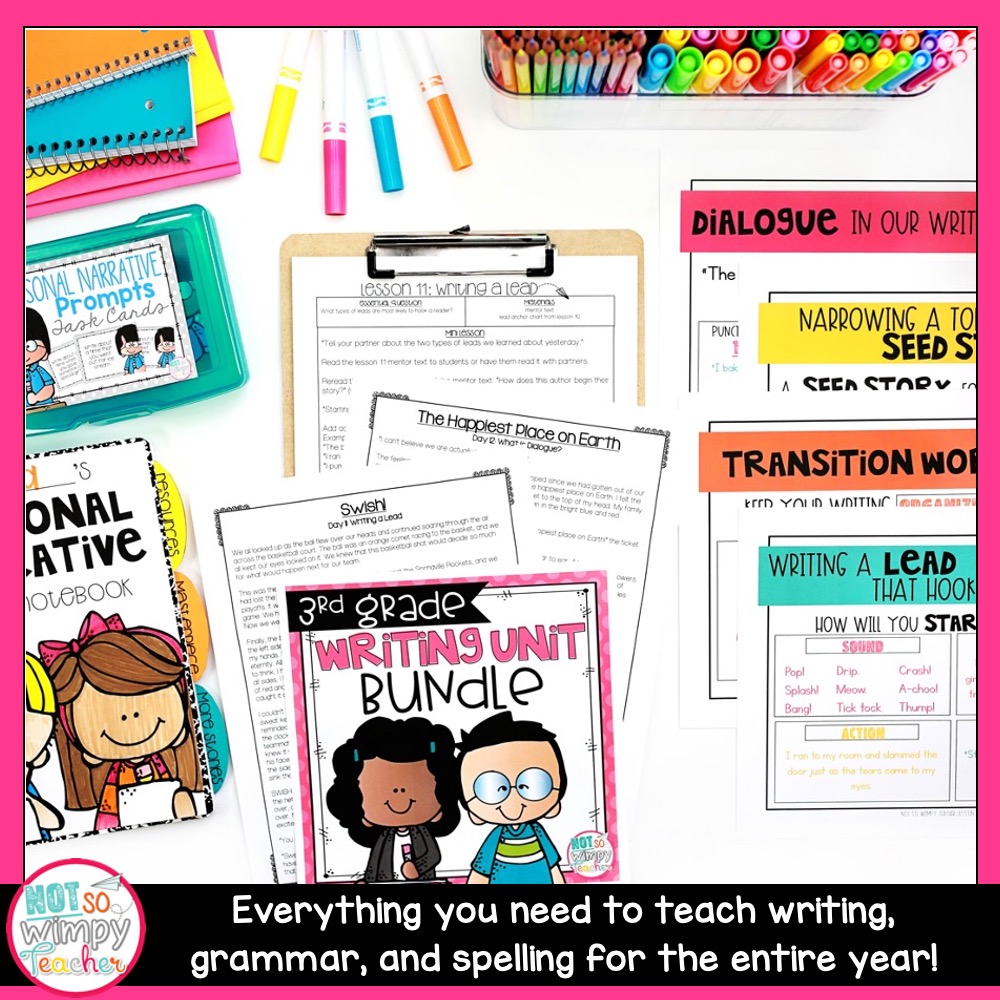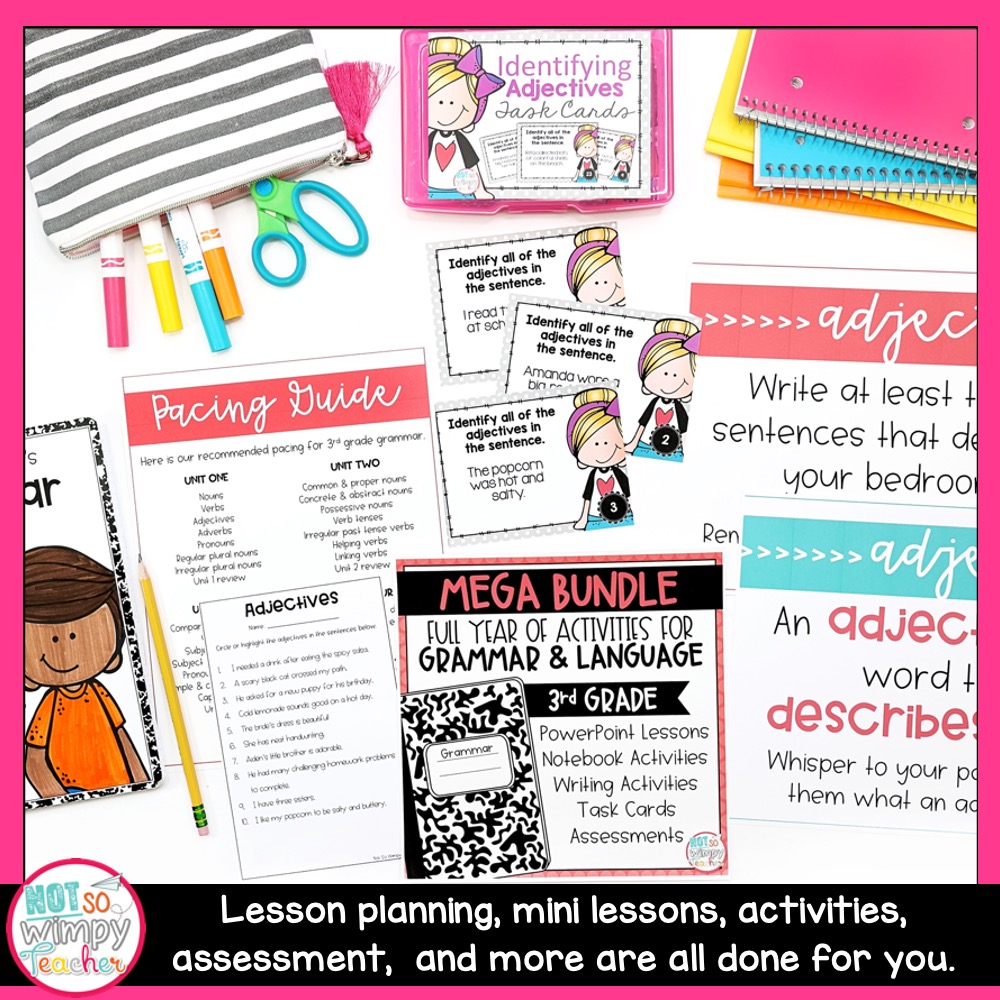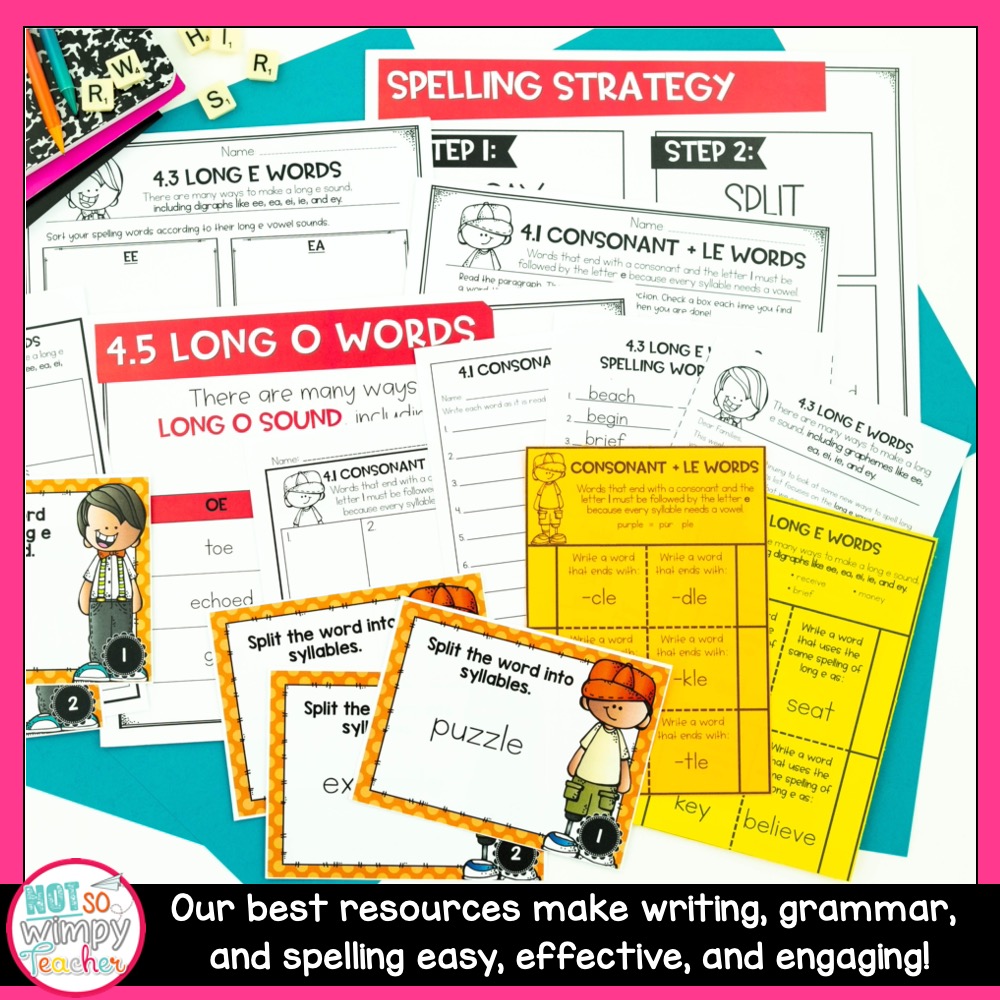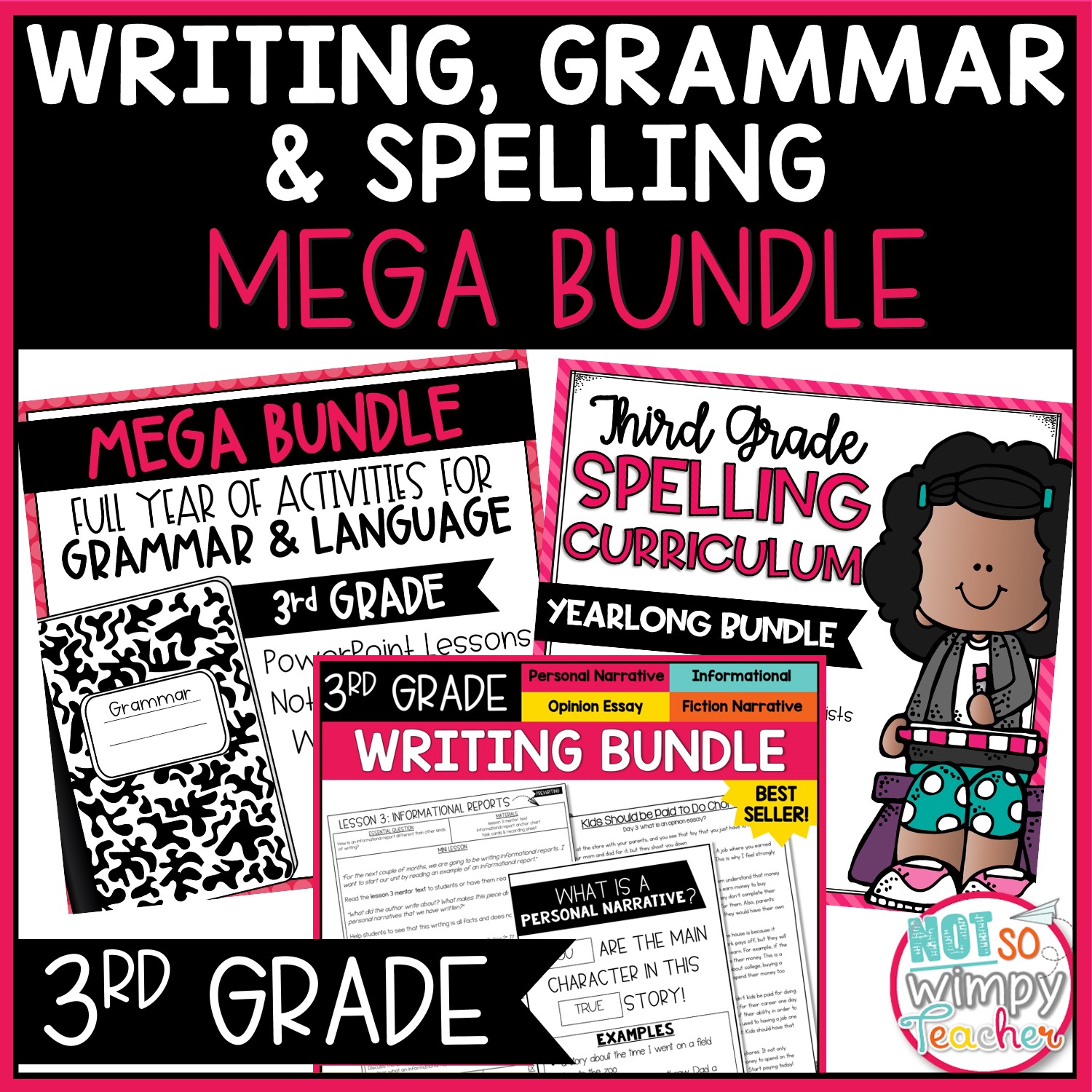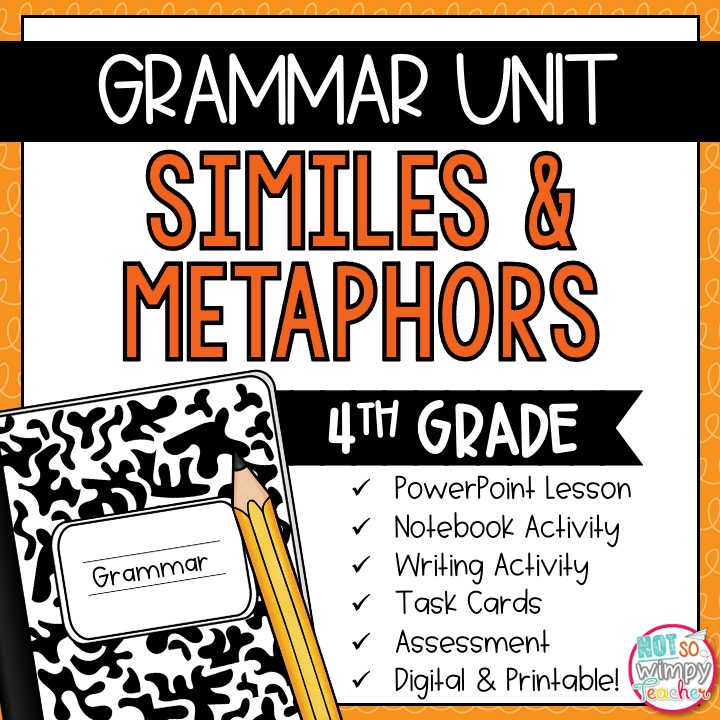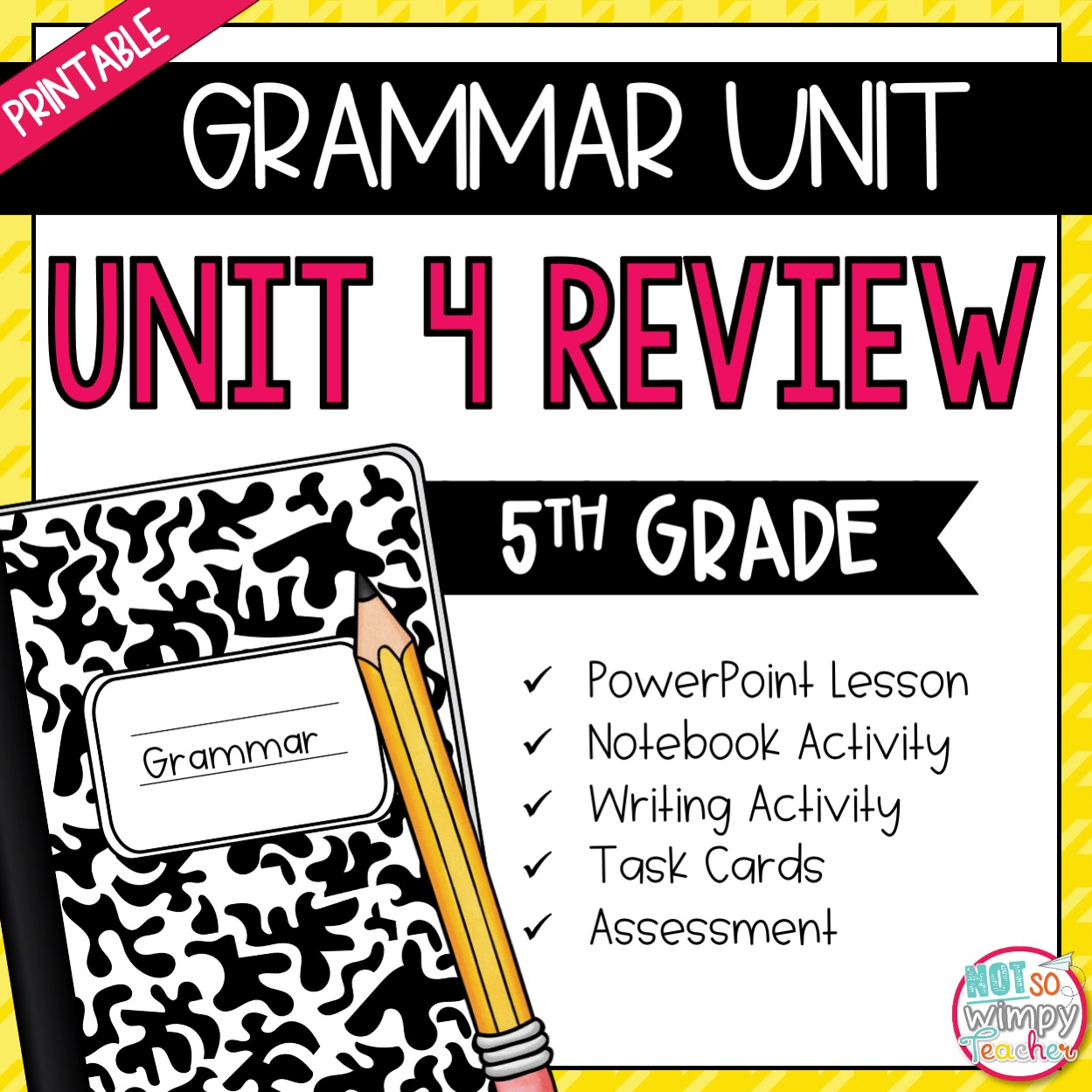Writing, Grammar, and Spelling Bundle THIRD GRADE
Save MORE with Lesson GenieMore about this resource
This third grade ELA resource includes EVERYTHING you need to teach grammar, writing, and spelling. There are lesson plans, mini lessons, student printables, interactive notebook activities, task cards, assessments, rubrics, and more. The flexible spelling curriculum includes 3 differentiated spelling lists each week. And all the materials are easy to implement, effective, and fun!
We’ve combined three of our most popular resources into one amazing mega bundle to save you time and money. This ELA resource includes our third grade grammar bundle, writing bundle and spelling curriculum bundle.*** Individually, these products would cost $293.00, but when you purchase them together you can get ALL THREE incredible resources for just $205. Talk about savings!
And, even better, you can relax knowing that you have EVERYTHING you need to teach fun, engaging, and effective ELA lessons in grammar, writing, and spelling every day. This bundle includes everything from mentor texts and anchor charts to assessments, including digital grammar assessments and writing celebration suggestions. We’ve planned it all out for you!
All of the lessons in this bundle are ready-to-use. All you have to do is print and teach. Each week follows the same routine. In grammar and spelling, there is a different activity each day, and the activities remain the same all year long. In writing, the lesson format is the same every day. This saves valuable time, makes class predictable, and facilitates learning.
This bundle also maximizes time for writing practice by weaving writing tasks through all three subjects. In grammar and spelling, students have weekly opportunities to practice new skills in context.
We’ve literally created everything you need to teach all the third grade writing and language standards and put it all together into one AMAZING product for you. Interactive whole group lessons, independent and partner practice, hands-on activities, writing throughout the curriculum, homework, review, assessments – it’s ALL included!
Spelling Curriculum
What’s Included:
- 4 8-week units (see the list below for individual skills)
- Differentiated spelling lists (4 each week) and family letter for each week.
- 28 Anchor charts assist visual learners and provide a student reference throughout each unit.
- PowerPoint Mini lessons teach the rule, pattern, or skill to be covered each week in a ready-to-use interactive lesson; all you have to do is display the slides.
- Interactive notebook activities (2 per week) reinforce spelling rules – one focuses on the general use of the rule and the other focuses on applying the rule specifically to the spelling list. The activities feature simple cuts to focus on grammar. All you need is a notebook, scissors, and glue.
- Task Cards (12 per week) are included for centers, review, or whole group activities.
- Practice sheets give students the opportunity to recognize the skill in written texts and bridge the gap between spelling and reading.
- Homework sheets (optional) provide additional practice before assessment.
- Assessments cover both the weekly spelling list and general skill.
- Cover and Table of Contents make student organization easy.
- Spelling Inventory allows you to easily assess students and decide which spelling list is right for them.
- Sample Schedules show how to implement the spelling program in 2-5 days per week.
- Detailed teacher directions provide flexibility and make implementation in the classroom easy.
- An FAQs section provides answers to commonly asked questions about the resource and helps you get started right away.
Skills Included:
- Word Families
- Consonants & Vowels
- Syllables
- Short Vowels
- Long Vowels
- Consonant Blends
- Digraphs sh/th/ph
- Unit One Review
- Using tch and ch
- Using ck and dge
- Double Consonants
- Closed Syllables
- Final e & Vowels
- Digraphs ay/ai
- Digraphs oy/oi
- Unit Two Review
- Digraphs ar/or
- Digraphs er/ir/ur
- Word Parts
- Suffixes Part 1: 1-1-1 Rule
- Suffixes Part 2: Final e Rule
- Suffixes Part 3: y to i Rule
- Word Families
- Review
- Consonants + le
- Long A
- Long E
- Long I
- Long O
- Long U
- Compound Words
- Unit Four Review
Grammar Bundle:
What’s Included:
- Detailed teacher instructions, including a recommended schedule for the week and instructions on how to use digital assessments
- 32 interactive PowerPoint presentations for the mini-lesson each week
- 32 student interactive notebook activities and JUST ADDED Answer Keys
- 32 sets of 24 task cards (NOW also in black and white) and a recording sheet (with answer key)
- Assessment (with answer key) including an editable digital assessment
Skills Included:
Unit One
Unit Two
- Common and Proper Nouns
- Concrete and Abstract Nouns
- Possessive Nouns
- Verb Tenses
- Irregular Past Tense Verbs
- Helping Verbs
- Linking Verbs
- Unit 2 Review
Unit Three
- Conjunctions
- Comparative and superlative adverbs and adjectives
- Subject & Predicate
- Subject & Verb Agreement
- Pronoun & Antecedent Agreement
- Simple & Compound Sentences
- Capitalizing Titles
- Unit 3 Review
Unit Four
- Dialogue
- Addresses
- Prefixes
- Suffixes
- Multiple Meaning Words
- Shades of Meaning
- Dictionary Skills (Entry and Guide Words)
- Unit Four Review
Also Included:
- Student Notebook Covers
- Teacher Binder Cover & Spine
Writing Bundle
What’s Included:
- 4 complete writing units: personal narrative, informational report, opinion essay, and fiction (see below for more detailed information on each genre)
- Detailed teacher directions and suggestions for simple implementation
- Unit-at-a-glance calendar for each unit
- 7 exclusive videos walking you through how to get the most out of these writing units
- 160 days of lesson plans that include guiding questions, materials, mini lessons, student work tasks, student share tasks, intervention, and several extension activities for
- 55 original mentor text passages
- 9 sets of task cards
- 50 teacher anchor charts (blank and filled-in versions)
- 57 student anchor charts and printables for writing notebooks
- Conference and goal-tracking forms
- Writing grades tracking forms
- Rubrics for all four genres
- List of 40 additional mentor textbooks (optional)
- Variety of writing publishing papers
- Student writing notebook covers and dividers
- Teacher notebook covers and binder spines
- Multiple ideas for author share celebrations
- DIGITAL writing notebooks on Google Slides
Personal Narratives
Students learn how to write a small-moment story with dialogue, a strong lead, interesting word choice, and paragraphs. Lessons include:
- Setting goals
- What is a personal narrative?
- Generating story ideas
- Narrowing your story idea to a small moment
- Rehearsing and drafting
- Writing a lead
- Adding and punctuating dialogue
- Adding details
- Word choice
- Show, don’t tell
- Breaking writing into paragraphs
- Transition words
- Writing an ending
- Editing
- Publishing
Informational Reports
Students learn how to craft a strong lead, choose interesting details, write topic and concluding sentences, and structure paragraphs. Lessons include:
- Setting goals
- What is an informational report?
- Generating report ideas
- Narrowing your report idea to a seed
- Research and note taking
- Paraphrasing
- Table of contents
- Subtopics
- Drafting
- Writing a lead
- Topic and concluding sentences
- Word choice- adding vocabulary and definitions
- Adding details
- Transitions
- Writing a conclusion
- Text features
- Editing
- Publishing
Opinion (Persuasive) Writing
Students learn how to use supporting facts and reasons, write topic and concluding sentences, and structure paragraphs. Lessons Include:
- Setting goals
- What is an opinion essay?
- Generating essay ideas
- Drafting
- Writing strong opinion statements
- Writing a lead
- Supporting your opinion with reasons
- Considering your audience
- Consider opposing opinions
- Supporting your opinion with examples
- Paragraphs
- Writing a lead
- Topic and concluding sentences
- Word choice
- Transitions
- Writing a conclusion
- Editing
- Publishing
- Generating deeper topics (research-based)
Students learn how to write dialogue, paragraphs, and transitions, and how to create strong characters, a problem, and a solution! Lessons include:
- Setting goals
- What is a fiction narrative?
- Developing characters
- Developing setting (show-don’t-tell)
- Problem & Solution
- Author’s point of view
- Writing a lead
- Creating suspense
- Adding and punctuating dialogue
- Word choice (strong verbs)
- Paragraphs
- Transitions
- Writing an ending
- Editing
- Publishing
Why You Will LOVE This Resource:
- EVERYTHING you need to teach engaging and effective ELA lessons in writing, grammar, and spelling all year long.
- Simple, ready-to-use lesson plans.
- Done-for-you PowerPoints that you can open and use to guide your whole-group lessons in grammar and spelling.
- Mentor texts and pre-printed anchor charts save valuable time and make teaching writing simple.
- Writing is woven throughout all the lesson plans.
- Daily and weekly routines save time and make implementation easy.
- Interactive notebooks and task cards provide hands-on learning opportunities.
- Easy to differentiate to meet the needs of all learners.
How to Use It in the Classroom:
Everything you need to teach engaging and effective writing, grammar, and spelling lessons is included!
- The spelling curriculum was designed to be flexible. You will need about 20 minutes to introduce the skill on the first day. Then you can teach spelling in about 10-15 per day, but you do not need to teach spelling every day for this program to be effective. Sample schedules show you how to teach spelling in 2-5 days per week.
- Grammar lessons can all be completed in 10 minutes per day!
- Writing lessons take between 30-45 minutes per day.
- We recommend teaching a daily 10-minute grammar lesson followed by a 30-45 writing lesson.
Spelling:
Weekly Routine (Based on a five-day routine):
- Day 1: PowerPoint mini lesson – whole group and individual practice; approximately 20 minutes
- Day 2: Interactive notebook and partner practice
- Day 3: Task card scoot
- Day 4: Practice sheet and partner practice; optional homework
- Day 5: Assessment
If you don’t have time for spelling all five days, use the sample schedules included to modify this routine:
- Flexibility is built into this program. It is designed to be used between 2-5 days per week. See the sample schedules for implementation ideas.
- You can use the PowerPoint mini lesson for your whole group instruction. Project on the whiteboard and have students participate in the interactive lesson. Students can write words on individual whiteboards or spell with a partner.
- Complete interactive notebooks as a whole group activity or have students completely independently, use them during centers or morning work.
- You can integrate spelling work into reading centers if time permits.
- Partner practice takes only five minutes and can take place at any time throughout the day – try before lunch, after recess, or before dismissal.
- Interactive notebook pages, task card answer sheets, and assessments come two to a page to save time, paper, and copy costs. Simply print one sheet for every two students and cut it in half.
- The weekly spelling list and family letter are printed on the same sheet to save time and paper.
- Practice sheets and homework can be printed front and back.
- If you use the NSW Grammar notebook, the spelling program can fit into the same notebook.
- Practice sheets can be completed independently, in small groups, or as a whole class.
Differentiation:
This program was designed to make differentiation easy:
- Each week includes three differentiated spelling lists, for beginner, on-track, and advanced spellers, as well as a combined list. ALL LISTS focus on the same rule each week. If you don’t want to use multiple lists, a fourth list provides a combination of different levels.
- Choose the appropriate list for each student; the spelling inventory can help you make the right choice.
- Reduce the number of spelling words to be memorized and focus on the spelling pattern.
- Assign the optional homework for extra practice.
- Use both Interactive notebook activities for additional practice.
- Allow students to use their spelling lists as a resource when using task cards and practice sheets.
- Work with beginning spellers to provide assistance as they complete the task cards.
- Provide additional time for partner practice.
- Challenge advanced students with specific directions for the “write a sentence” part of the practice activity.
- Grade both the spelling lists and spelling pattern part of the assessments, or just grade one section.
Grammar:
Each week follows the same routine. This saves time and students know what to expect:
- Monday: Interactive PowerPoint mini lesson introduce students to a new grammar skill
- Tuesday: Interactive notebook activity includes foldables and flaps that students manipulate to deepen conceptual understanding. Great for kinesthetic learners. Feature simple cuts to keep the emphasis on grammar. All you need are notebooks, scissors, and glue.
- Wednesday: Grammar writing prompt helps students apply new grammar skills.
- Thursday: Task card scoot provides a hands-on review that incorporates movements
- Friday: Assessment. Both printable and an editable digital assessment compatible with Google Classroom make assessment quick and easy. You can edit the digital assessment to meet your students’ needs.
Differentiation:
There are many ways to differentiate this grammar lesson:
- Complete interactive notebook activities in small groups to provide additional support
- Allow students to use interactive notebooks as a reference during the writing activity or task cards
- Have students complete fewer task cards
- Move around the room with students who need additional support during the task card scoot
- Use the edible digital assessment to customize weekly assessments
Writing
I recommend you set aside 30-45 minutes for writing each day (or more if you have it). Each day follows the same plan:
- Mini Lesson (8-10 minutes): The day kicks off with a mini lesson to teach a particular skill. The mini lesson uses mentor text (remember, it’s included in the unit) and anchor charts. For the teacher version of the anchor charts, you can project and fill them out with the class, or print and display them in your classroom. The student versions are smaller so they can fill them out and keep them in their writing notebooks for reference.
- Work Time (18-20 minutes): Students will apply the skill they just learned into their writing each day. The included writing tasks make it crystal-clear what to do during independent writing time–for you and your students. By the end of the unit, they will have completed two full masterpieces and many other independent writings.
- Share Time (2 minutes): Students are encouraged to share a piece of their writing with a partner or with the entire class. This makes writing more meaningful to kids and holds them accountable.
Organization made easy:
- The Writing Bundles are divided into 4 units of study: personal narrative, informational report, opinion essay, and fiction narrative which each comes in its own unit folder.
- Each unit folder is further organized into multiple folders and files so it’s easy for you to find what you need.
- Each unit comes with a daily schedule so you know exactly what to teach each day.
- Detailed daily lesson plans make teaching writing easy.
Differentiation:
There are many ways to differentiate writing assignments:
- These daily writing prompts are intentionally short and sweet so that all students, even those below grade level, can feel successful. Most tasks can be completed in 1-2 sentences.
- More advanced writers can write longer responses, or work on a second masterpiece if they finish early.
- Students can complete fewer task cards or work with a partner; you can also provide support to students as they work on task cards.
- The process for teaching writing includes group conferencing time. These groups should be based on ability so that you can individualize your instruction to meet the specific needs of the group.
